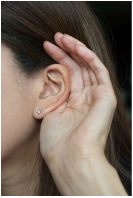
Speech perception is not only hearing the sounds another person speaks, but also interpreting and understanding those sounds. It’s being able to tell the difference between the words, “pat” and “bat.”
You may be thinking, “I don’t need help understanding people. I need help with my pronunciation.” What you may not realize, though, is that improving your speech perception will help you improve your accent too.
Why is speech perception important to learning how to improve my accent?
The first step in improving your accent is learning to hear the difference between what you’re saying and what you should be saying in order for others to understand you more clearly. You may, for example, be substituting one sound for another or not saying the target sound at all. If you cannot hear the difference between the wrong sound you are pronouncing (error) and the sound you should be saying (target sound), it will be difficult to change your accent.
You may be thinking, “I don’t need help understanding people. I need help with my pronunciation.” What you may not realize, though, is that improving your speech perception will help you improve your accent too.
Why is speech perception important to learning how to improve my accent?
The first step in improving your accent is learning to hear the difference between what you’re saying and what you should be saying in order for others to understand you more clearly. You may, for example, be substituting one sound for another or not saying the target sound at all. If you cannot hear the difference between the wrong sound you are pronouncing (error) and the sound you should be saying (target sound), it will be difficult to change your accent.
How do I use speech perception to change my accent?
With many of my students, I use what is called the Minimal Pairs technique. A minimal pair is a word that differs from another word by only one sound. Some examples include:
I use lists of minimal pairs to help my students hear the difference between what they usually say (the error sound) and what they should say (the correct target sound).
By pairing these words, my students begin to:
Many of my students have told me, “Really, you say it that way?” I have been saying that word the wrong way for 8 years! Now I know why people can’t understand me.”
When students start learning the correct pronunciation with me, they also begin to hear it in their environments. After working a couple of weeks using the Minimal Pairs technique, one student told me, “I have a co-worker who speaks Spanish. I can now tell the difference between her incorrect pronunciation of this sound, the one I used to use too, and the pronunciation of my American co-workers. Now I know how to say it the right way.”
Improving your speech perception will help you improve your accent, making you more clear to others and ultimately, more confident in your speaking abilities.
With many of my students, I use what is called the Minimal Pairs technique. A minimal pair is a word that differs from another word by only one sound. Some examples include:
- bear and pear - the /b/ and /p/ are different, but “air” is pronounced the same
- be and see - the /b/ and /s/ are different, but “ee” is pronounced the same
- fin and tin - the /f/ and /t/ are different, but the “in” is pronounced the same
I use lists of minimal pairs to help my students hear the difference between what they usually say (the error sound) and what they should say (the correct target sound).
By pairing these words, my students begin to:
- Hear the difference between their pronunciation and that of Standard American English
- Replace their error sound with the correct target sound, allowing them to speak more clearly
- Understand why others may have difficulty understanding their speech (i.e. that someone may not understand, “Can you give me a peas?” instead of “Can you give me a piece?”
Many of my students have told me, “Really, you say it that way?” I have been saying that word the wrong way for 8 years! Now I know why people can’t understand me.”
When students start learning the correct pronunciation with me, they also begin to hear it in their environments. After working a couple of weeks using the Minimal Pairs technique, one student told me, “I have a co-worker who speaks Spanish. I can now tell the difference between her incorrect pronunciation of this sound, the one I used to use too, and the pronunciation of my American co-workers. Now I know how to say it the right way.”
Improving your speech perception will help you improve your accent, making you more clear to others and ultimately, more confident in your speaking abilities.
 RSS Feed
RSS Feed